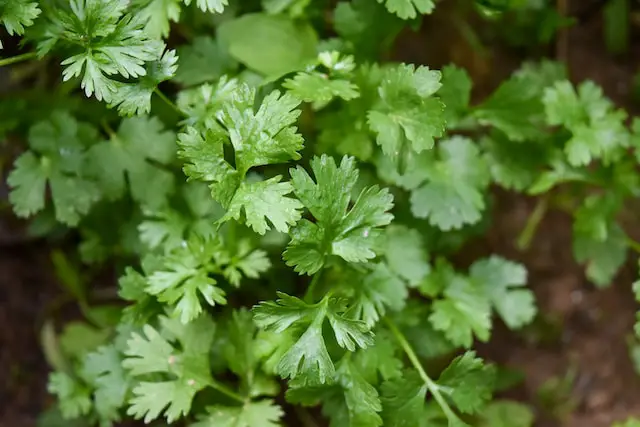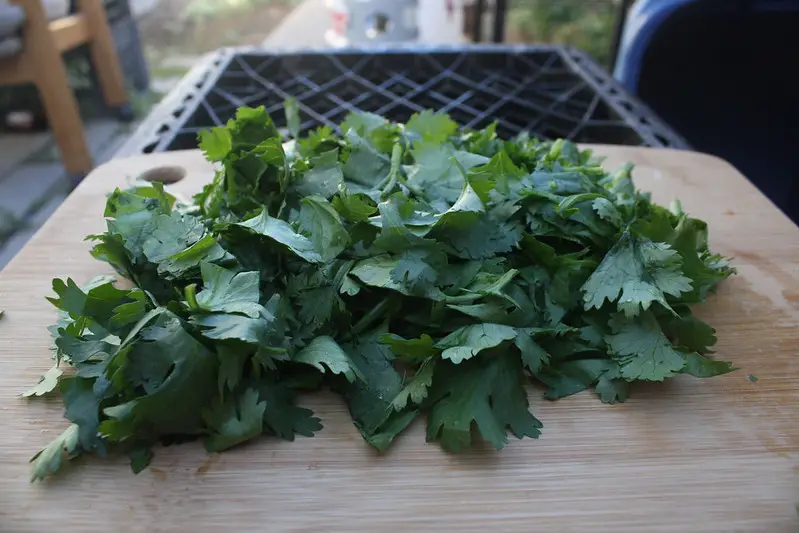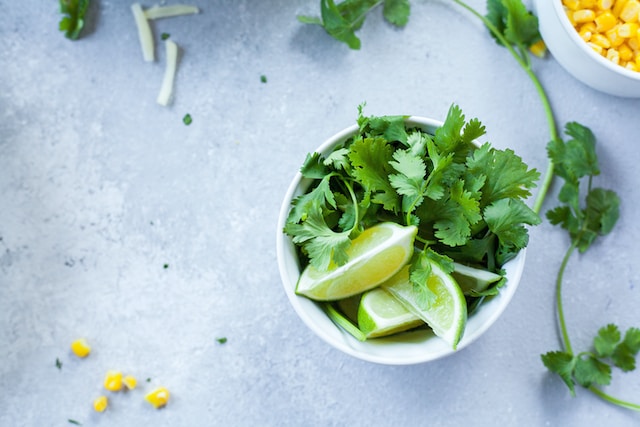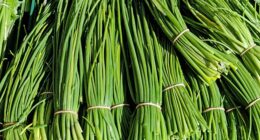Parsley and cilantro may look similar but they have distinct differences in their appearance, taste, and uses. While both herbs are great for adding flavor to dishes, it is important to use them appropriately based on the recipe requirements.
Parsley
(Photo by Chandan Chaurasia on Unsplash )

Parsley is a herb that belongs to the same family as celery, carrots and fennel. It’s known for its bright green color and fresh aroma. The two most common types of parsley are curly parsley and Italian flat-leaf parsley.
Curly parsley has a mild flavor and is often used as a garnish for dishes like potato salad or deviled eggs. Meanwhile, Italian flat-leaf parsley has a stronger taste that works well in soups, stews, marinades and sauces.
Aside from being an excellent source of vitamins A, C and K, parsleys’ health benefits also include anti-inflammatory properties that can help reduce swelling in the body. Additionally, it contains antioxidants which can help prevent cell damage caused by free radicals.
Incorporating fresh herbs like parsley into your diet not only adds flavor but also brings valuable nutrients to your meals. Whether you’re making homemade pesto or adding some extra zest to your favorite salad recipe – give this versatile herb a try!
Cilantro
(Photo By Wheeler Cowperthwaite on Flickr)

Cilantro is a leafy herb commonly used in Mexican, Indian, and Southeast Asian cuisine. It has a distinctive flavor that can be described as citrusy and slightly spicy. Cilantro leaves are delicate and should be added to dishes towards the end of cooking to preserve their aroma.
One of the most popular uses for cilantro is in salsa. The freshness of the herb pairs well with tomatoes, onions, and lime juice to create a flavorful dip or topping for tacos and other Mexican dishes. Cilantro can also be used in marinades for meat or fish to add depth of flavor.
In addition to its culinary uses, cilantro has been praised for its health benefits. It contains antioxidants that may help reduce inflammation and protect against chronic disease. Some studies have even suggested that cilantro could have antibacterial properties.
While some people love cilantro’s unique taste, others find it overpowering or even unpleasant due to genetics. Nonetheless, if you’re looking to try something new in your cooking or boost your intake of antioxidants, give this versatile herb a chance!
Parsley Vs. Cilantro – Key differences
Parsley and cilantro are two popular herbs that often get mixed up in the kitchen. While they may look alike, they have distinct differences when it comes to their flavor and usage.
One of the key differences between parsley and cilantro is their taste. Parsley has a milder taste compared to cilantro’s strong, pungent flavor. Cilantro is also known for its distinctive citrusy notes, while parsley has a more grassy taste.
Another difference is how they are used in cooking. Parsley is commonly used as a garnish or an ingredient in sauces, soups, stews, and salads. On the other hand, cilantro is widely used in Mexican cuisine as well as Asian dishes such as curries and stir-fries.
When it comes to appearance, both herbs have different leaf shapes – parsley’s leaves are flat while cilantro’s leaves are rounder with serrated edges. Additionally, parsley has a darker green color compared to cilantro’s lighter shade of green.
These two herbs belong to different botanical families – parsley belongs to Apiaceae family (also known as umbellifers) while cilantro belongs to Coriandrum sativum family (also called corianders).
Knowing the key differences between these two flavorful herbs can elevate your dishes’ taste profiles significantly!
When to use parsley in cooking?
When it comes to cooking, parsley is a versatile herb that can be used in many dishes. It pairs well with both savory and sweet flavors, making it a popular choice for cooks around the world. Here are some tips on when to use parsley in your cooking.
Firstly, fresh parsley leaves make an excellent garnish for almost any dish. They add color and freshness to soups, stews, salads or roasted vegetables. You can also chop up parsley finely and sprinkle it over pasta dishes like spaghetti Bolognese or carbonara.
Parsley has a slightly bitter taste which makes it perfect for balancing out rich flavors such as red meat or oily fish like salmon. Add chopped parsley into your marinade before grilling steak or mix with breadcrumbs before coating chicken breasts – this will help tone down any heavy flavorings you may have added.
Another great way to incorporate parsley into your cooking is by infusing oils or vinegars with its flavor. Simply blend together freshly picked herbs with olive oil then drizzle over salad greens- the possibilities are endless!
Don’t forget about the nutritional value of parsley! It’s packed full of vitamins and minerals including vitamin C & K which support healthy immune systems while aiding digestion too!
When to use Cilantro in cooking?
Cilantro is a staple in many cuisines around the world, especially those of Latin America and Southeast Asia. Its unique flavor profile makes it perfect for adding a fresh, citrusy taste to dishes.
One popular use for cilantro is in salsa and guacamole. The herb’s bright flavor pairs well with the richness of avocados and tomatoes, making it an ideal ingredient for these classic dips.
In addition to Mexican cuisine, cilantro is also commonly used in Thai and Indian cooking. In Thai cuisine, it often appears in soups such as tom yum or as a garnish on curries. In Indian cooking, cilantro is usually added towards the end of the cooking process to add freshness to dishes like chutneys or chicken tikka masala.
If you’re looking for new ways to incorporate cilantro into your meals, try using it as a topping on tacos or mixing it into rice dishes like paella or biryani. It can also be blended into dressings or sauces for added depth of flavor.
There are countless ways to use cilantro in cooking – so don’t be afraid to get creative!
Recipes that use parsley?
Parsley is a versatile herb that can be used in many different types of recipes. One classic recipe that uses parsley is tabbouleh, a Middle Eastern salad made with bulgur wheat, tomatoes, onions, and lots of fresh herbs including parsley.
Another popular dish that features parsley is chimichurri sauce. This Argentinean sauce is made with fresh parsley and other ingredients like garlic, vinegar, and chili flakes. It’s commonly served as an accompaniment to grilled meats or vegetables.
Parsley can also add a pop of color and flavor to pasta dishes like spaghetti aglio e olio. Simply sauté some garlic in olive oil and toss cooked spaghetti with chopped parsley for an easy weeknight meal.
For those who love soup, adding freshly chopped parsley to chicken noodle soup or minestrone can enhance the overall taste profile of the dish.
There are countless ways to use parsley in your cooking routine. Whether you’re making salads, sauces or soups – don’t forget this flavorful herb!
Recipes that use cilantro?
Cilantro’s bright and fresh flavor is popular in many cuisines, from Mexican to Southeast Asian. Here are some recipe ideas that use cilantro as a key ingredient:
Salsa: Cilantro adds a punch of freshness to homemade salsa. Chop up some tomatoes, onions, jalapenos, and cilantro for a simple yet delicious dip.
Guacamole: Another classic dip that features cilantro is guacamole. Mashed avocados mixed with onion, tomato, lime juice and lots of chopped cilantro make this dish perfect for any party or gathering.
Thai Curry: Cilantro also brings its unique flavor to Thai curries like green curry chicken or vegetable red curry dishes.
Tacos: Cilantro is often used as a garnish on tacos but can also be added directly into the filling mixtures such as carnitas or carne asada tacos.
Rice Bowls: Freshly chopped herbs add an element of brightness to rice bowls so adding some cilantro will give your grains more depth of flavour while keeping it fresh at the same time!
These dishes just scratch the surface when it comes to recipes that incorporate cilantro – there are endless possibilities!
Can you substitute cilantro for parsley?
If you’re a fan of cilantro but your recipe specifically calls for parsley, you might be wondering if the two herbs are interchangeable. While they may look similar and have some overlapping flavors, the answer is not always straightforward.
First of all, it’s important to note that cilantro has a much stronger flavor than parsley. Its taste can be described as citrusy with hints of spice and sweetness. On the other hand, parsley has a milder flavor that is slightly bitter and grassy.
In certain dishes where parsley is used primarily for its appearance or texture rather than flavor (such as in tabbouleh), substituting cilantro could work well. However, in recipes where parsley plays a more prominent role in terms of taste (like in Italian cuisine), swapping it out for cilantro could drastically alter the final dish.
Ultimately, whether or not you can substitute cilantro for parsley depends on personal preference and the specific dish you’re making. If you do decide to make the switch, start by using less cilantro than called for and adjust based on taste as needed.
Featured Image By – Lindsay Moe on Unsplash








